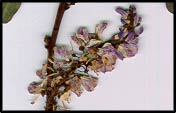South West Slopes Revegetation Guide
Indigofera australis
Austral Indigo
Select from the following for detailed images.
Species Information
| Synonyms |
|
| Common Names |
Austral Indigo; Hill Indigo, Native Indigo. |
| Family |
Fabaceae - Pea family. |
| Name Origin |
Indigofera - neo-Latin for indigo-bearing. australis - Latin for southern. |
Specimen Data - CSU 1094
| Location |
Brittas Reserve Road near Culcairn, NSW. Mount Pilot, intersection of Old Coach Road and Warners Road, Victoria. |
| Notes |
Zone: 55 Easting: 474026 Northing: 5986929 |
| Collector |
Earl, Gill & Kent, Kylie |
Date |
23/09/1999 |
| Determined By |
Kent, Kylie |
Date |
16/03/2000 |
South West Slopes Revegetation Guide Information
| Regional: |
Widespread. Noted in most areas across region. |
| Australia: |
Mainland except for NT. |
| Habitat: |
Woodland and eucalypt forest. Commonly hilly areas. |
| Habit: |
Open erect spreading shrub to 2.5 m high. Long slender stiff stems. |
| Similar Species: |
|
| Site Preference: |
|
| Characteristics: |
|
| Flowering: |
Mauve to purple (sometimes white), winter-spring. Pea-like. |
| Seed Collection: |
Mid Nov to early Feb. Monitor closely as seeds shed immediately or very soon after maturity. Ensure collection by securing nylon stockings or paper bags to fruiting branches after flowering. |
| Propagation: |
From scarified seed or cuttings. Pour boiling or very hot water over seeds and soak until water cools. Dry |
| Regeneration: |
From seed, particularly after fire. Establishes readily when direct seeded. |
| Timber: |
|
| Shade and Shelter: |
Useful low-level cover in windbreaks. |
| Land Protection: |
Legume - improves soil fertility by 'fixing' nitrogen. |
| Wildlife: |
Excellent habitat. Flowers are a pollen and nectar source for many native insects, including bees and wasps. Also food for butterfly caterpillars. |
| Ornamental: |
Attractive ornamental, particularly when flowering. Plant in groups for best effect. Tip prune from when young to promote bushiness and prevent straggliness. Cut dead or straggly branches at base. Coppices. |
| Other: |
Roots hammered and placed in salt or fresh water to poison fish. Leaves and stems produce yellow-fawn dye with alum as mordant. |
Note: The following information presented is only a guide, as plant characteristics vary depending on provenance (the plant's locality).
| Site/Preferred Habitat : |
poor, shallow soils in semi-shade |
| Rainfall(mm) : |
300+ |
| Growth Rate : |
fast |
| Tolerates : |
moderate frost & wet periods |
| Resents : |
|
| Uses & Comments : |
windbreak; fixes nitrogen; wildlife; ornamental |
Return to Database List
